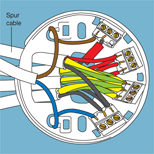LAST UPDATED: 9th January 2023 by The Editorial Team

Summary: Step by step guide and video showing how to add an electrical socket outlet and run a spur from a junction box.
Contents
How to extending an electrical circuit
* Notifiable project requiring Building Control approval if installation is located in a kitchen, bathroom or other special location.
To supply new power outlets on a ring main circuit, run a spur from the main circuit. To run a spur from a radial lighting circuit to add lighting points see the section on extending a lighting circuit. You must be certain that the circuit will not be overloaded and the maximum floor area for the circuit is not exceeded. Consult the sections on circuits of you are unsure.

Running a spur from a socket outlet
The easiest way of adding a new socket outlet or a fused connection unit (FCU) is to run a spur from an existing socket. Using a continuity tester, check that the socket is not itself supplied by a spur or supplying another spur.
- Cut off the power supply to the relevant circuit from the consumer unit.
- Remove the face-plate from the socket you will be running a spur from.
- Knock out the tab in the side of the mounting box to admit a new cable.
- Prepare the cable route from the existing socket outlet to the position of the new socket or FCU. If you do not wish to cut a chase in the walls, you can conceal the cables with trunking.
- Fix the new socket mounting box to the wall, following the directions for installing a mounting box
- Measure the distance between the old and new sockets and cut a length of cable to fit between them.
- Feed the cable into both mounting boxes.
- Prepare the cable ends.
- At the new outlet, connect the live core (brown) to terminal L.
- At the existing socket outlet, connect the new cable cores to the corresponding terminals. If the wiring is colour-coded according to the old system, you may need to connect 1 red and 1 brown core to the live terminal, and 1black and 1 blue core to the neutral terminal.

Running a spur from a junction box
If you have floorboards, it may be easier to run the spur directly from the ring main circuit cable under the floor via a 30 amp three-terminal junction box.
- Cut off the power supply to the relevant circuit from the consumer unit.
- Lift the floorboards near an existing socket outlet to locate the circuit cable.
- Check that you have the right cable using a continuity tester.
- Hold the junction box against the side of a joist and cut the cable over the junction box.
- Prepare the cable route from the junction box to the new socket outlet.
- Fix the new socket mounting box following the instructions for installing a mounting box.
- Prepare the ends of the spur cable.
- Connect one end of the cable to the socket face-plate following the instructions for installing a socket.
- Connect the other end to the junction box: connect both ends of the existing circuit cable and the new spur cable to the same terminals in the junction box: earth core to the central terminal; live core (brown/red) to the terminal below right; neutral core (blue/black) to the terminal above left.
- Screw the junction box base to the side of a joist.
- Screw the junction box cover over the base.
Tools Needed
- Continuity tester
- Insulated screwdriver
- Wire cutters/strippers
- Trimming knife
Materials needed
- Trunking
- Socket mounting box
- Cable
Important note
The colour-coding system for electric cable changed in 2006, make sure you read Electric cable and flex to view the new information.
Adding a socket to a ring or radial circuit video
Author
Related projects
- Extending a lighting circuit
- Installing a new electric socket
- Preparing cable and flex for connection
- Replacing a socket
- Installing an outdoor socket
- Converting a single socket outlet to a double socket
